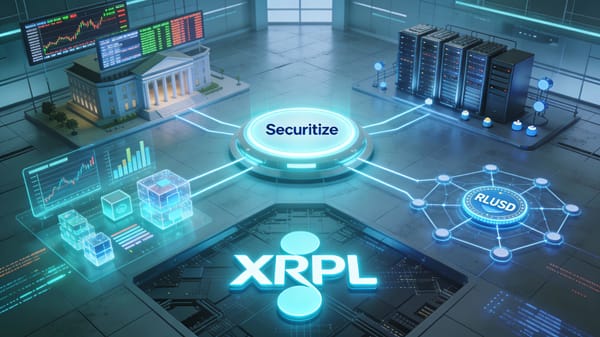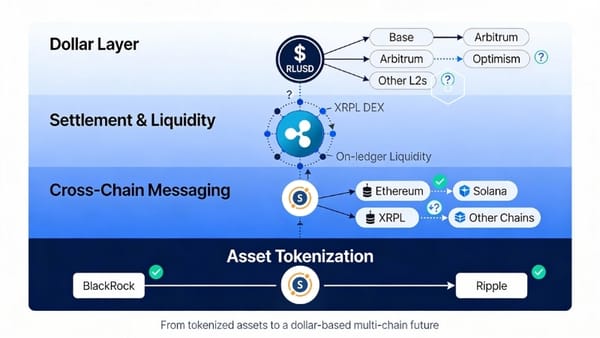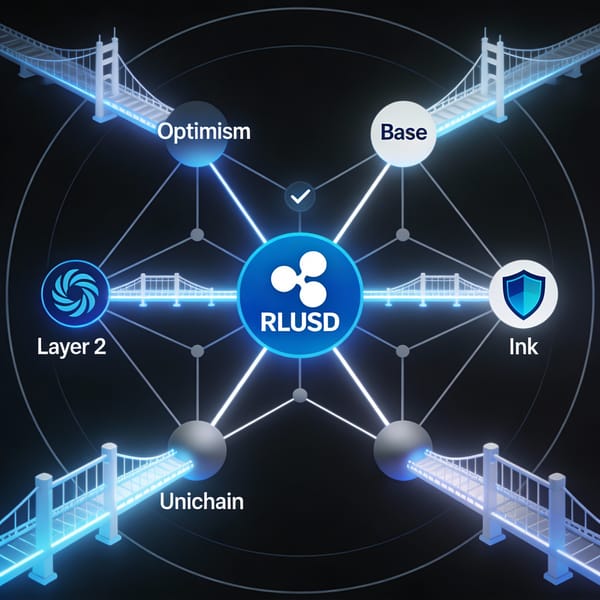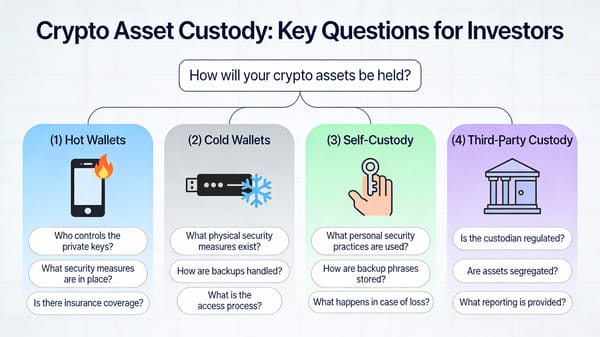Yellow Network Bridges to XRPL EVM: RWA Trading Gets Layer-3 Boost
Yellow Network integrates Layer-3 clearing protocol with XRPL EVM Sidechain, enhancing RWA trading infrastructure through state channels and institutional-grade settlement capabilities.
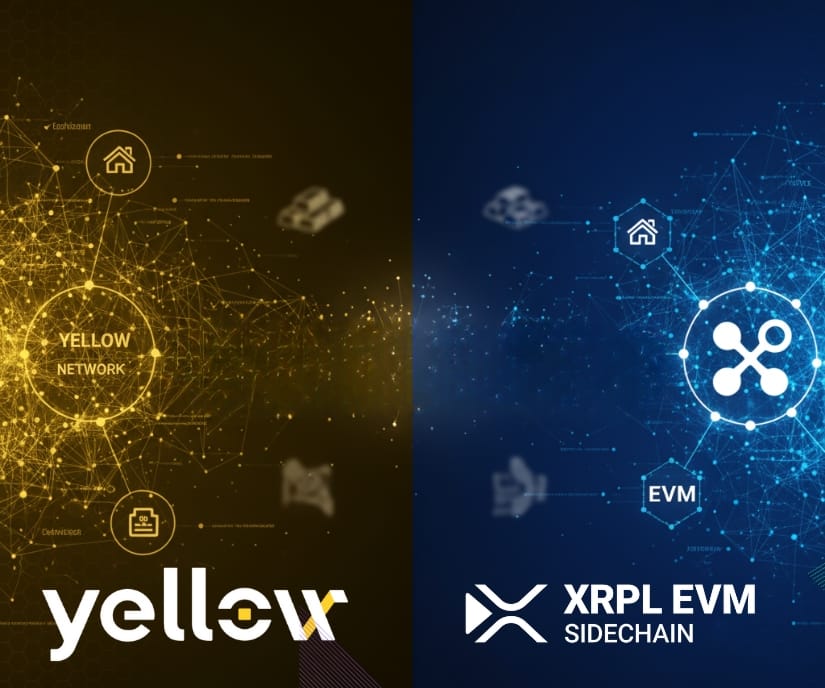
Yellow Network has announced the integration of its Layer-3 clearing protocol, Yellow Clearnet, with the XRPL EVM Sidechain, marking a significant development in the infrastructure supporting real-world asset (RWA) tokenization and decentralized trading. This collaboration connects Yellow's state channel technology with the XRP Ledger ecosystem, potentially enhancing liquidity and settlement efficiency for tokenized assets.
BIG NEWS! 🚨
— Yellow (@Yellow) October 23, 2025
Yellow is integrating with the XRPL EVM Sidechain!
Our Layer 3 clearing network now connects to @Peersyst’s XRPL ecosystem, unlocking faster, gas efficient trading and real time settlement for tokenized assets.
Where interoperability meets performance. pic.twitter.com/5DTDWiUWOT
State Channels Meet Institutional-Grade Infrastructure
Yellow Clearnet operates as a Layer-3 overlay network that enables real-time, non-custodial cross-chain trading through state channel technology. State channels allow transactions to occur off-chain between parties, with only the final settlement recorded on the blockchain. This approach addresses critical scalability limitations that have constrained decentralized markets, enabling high-frequency trading without overwhelming base layer networks.
Founded in 2018 by Louis Bellet and Alexis Sirkia, Yellow Network emerged as a response to liquidity fragmentation across blockchain ecosystems. The platform's architecture draws inspiration from Bitcoin's Lightning Network but extends the concept beyond simple value transfer to comprehensive clearing and settlement operations. Yellow's ClearNode infrastructure functions as a trustless execution layer, coordinating liability updates across participants and enforcing net settlements on multiple blockchains.
The XRPL EVM Sidechain, which launched on mainnet June 30, 2025, brings Ethereum Virtual Machine compatibility to the XRP Ledger ecosystem. Built in collaboration between Peersyst and Ripple, the sidechain uses XRP as its native gas token and connects to XRPL mainnet via the Axelar bridge, providing interoperability with over 80 blockchain networks. The sidechain employs a Proof of Authority consensus mechanism, achieving 3.5-second block times and capacity for 1,000 transactions per second.
Multi-Chain Architecture Expands Trading Infrastructure
Yellow Clearnet's integration with XRPL EVM Sidechain represents the latest addition to a growing multi-chain architecture. The platform already maintains operational integrations with Ethereum, Polygon, and Binance Smart Chain, with planned connections to Solana, Bitcoin, and Polkadot networks on the roadmap. This chain-agnostic design enables Yellow to aggregate liquidity across fragmented blockchain ecosystems without requiring constant asset bridging.
According to statements from Yellow Network, the integration aims to enhance both liquidity availability and traceability for RWA transactions. The platform's state channel architecture processes trades off-chain at high frequency, batching liability updates between counterparties and committing only net settlement results to base chains for finality. This infrastructure reportedly supports billions of messages per day while maintaining the security guarantees of on-chain settlement.
The strategic importance of Yellow Network has attracted significant backing from the crypto industry. Ripple co-founder Chris Larsen led a $10 million seed funding round in September 2024, signaling institutional confidence in the Layer-3 clearing approach. Yellow Network's ecosystem includes partnerships with established blockchain projects including Avalanche, Polygon, Flow, and institutional players such as GSR and Linea, demonstrating broad industry support for its multi-chain clearing infrastructure. The platform has also appointed experienced technology leadership, including Alessio Treglia and Hongtao J as co-CTOs, to accelerate development of its SDK and NeoDAX institutional trading framework.
Real-World Assets and the XRP Ledger Ecosystem
The integration arrives as RWA tokenization gains substantial momentum across the crypto industry. The XRP Ledger has positioned itself as a primary infrastructure layer for institutional asset tokenization, with Ripple actively developing compliance-ready features and custody solutions. The tokenization market is projected to reach nearly $19 trillion by 2033, according to industry estimates, with some forecasts suggesting the total addressable market could exceed $867 trillion across all asset classes.
XRPL's institutional appeal stems from several technical characteristics. Transactions settle in 3-5 seconds at fractions of a cent, using minimal energy consumption through its consensus mechanism. The ledger includes native functionality for tokenization, trading, and asset control without requiring complex smart contracts. Its built-in decentralized exchange and automated market maker pools provide immediate liquidity access for issued tokens. The network has processed over 3.9 billion transactions since 2012 with zero security breaches.
Major financial institutions have already deployed RWA tokenization projects on XRPL. UK-based Archax tokenized abrdn's £3.8 billion Liquidity Fund on the ledger, marking a significant milestone for regulated finance. Ondo Finance is launching tokenized treasuries backed by BlackRock's USD Institutional Digital Liquidity Fund on XRPL. Singapore-based OpenEden surpassed $100 million in total value locked for tokenized US Treasury Bills, with a $10 million investment from Ripple itself. Latin American exchange Mercado Bitcoin announced plans to tokenize $200 million in RWAs on the XRP Ledger.
The XRPL EVM Sidechain has demonstrated rapid developer adoption. Within its first week of mainnet operation, the sidechain recorded deployment of nearly 1,400 smart contracts, signaling strong early momentum. Cross-chain bridges from Axelar and Wormhole have injected over $100 million in daily liquidity, accelerating XRPL's role in the multi-chain ecosystem.
Implications for XRP and Market Positioning
For XRP holders and the broader Ripple ecosystem, Yellow Network's integration with XRPL EVM Sidechain could strengthen the ledger's position in the competitive RWA tokenization landscape. XRP functions as the native gas token for the EVM sidechain, creating organic demand as transaction volume increases. Every tokenized asset transaction, stablecoin swap, or cross-chain settlement potentially requires XRP for liquidity and fee settlement.
The integration may enhance XRP's utility beyond its established use cases in cross-border payments through Ripple's On-Demand Liquidity service. As institutional adoption of XRPL for RWA tokenization grows, XRP's role as a bridge asset and settlement currency within the ecosystem could expand. Market analysts have speculated on potential price impacts if XRPL captures significant market share in the tokenization sector, though such projections remain highly speculative and dependent on numerous factors including regulatory developments.
Ripple CTO David Schwartz has emphasized XRPL's potential to bridge traditional finance and decentralized finance, combining regulatory compliance with open blockchain infrastructure. The Dubai Financial Services Authority's recognition of XRP and Ripple's RLUSD stablecoin as regulated assets within the Dubai International Financial Centre represents a significant regulatory milestone that could accelerate institutional adoption.
From a partnership perspective, Yellow Network's backing by Ripple co-founder Chris Larsen creates natural alignment between the Layer-3 protocol and the XRP Ledger ecosystem. The integration positions XRPL as not merely a fast settlement layer but as part of a comprehensive infrastructure stack that includes high-frequency trading capabilities, institutional custody solutions, and cross-chain liquidity aggregation.
Technical Architecture and Developer Accessibility
The technical integration between Yellow Clearnet and XRPL EVM Sidechain leverages complementary strengths. Yellow's state channel infrastructure handles high-frequency liability updates off-chain, while XRPL's fast finality and low transaction costs make it an efficient settlement layer for batch transactions. The EVM compatibility of the sidechain enables developers to deploy Solidity-based applications while accessing XRP's liquidity and XRPL's native decentralized exchange.
For developers, the integration offers plug-and-play access to Yellow's SDK and NeoDAX framework alongside XRPL's established tooling. The Yellow SDK provides modular components for building scalable cross-chain applications, while NeoDAX offers institutional-grade trading infrastructure supporting hundreds of thousands of transactions per second. Projects building on XRPL EVM Sidechain can now potentially access Yellow's unified liquidity pool across multiple blockchain networks.
The sidechain's integration with MetaMask through XRPL Snap ensures familiar user experiences for Ethereum developers and users transitioning to the XRPL ecosystem. The Axelar bridge's decentralized architecture provides secure asset transfers while the EVM compatibility eliminates the need to learn new programming languages or restructure existing code.
Market Context and Competitive Landscape
Yellow Network's integration with XRPL EVM Sidechain occurs amid intensifying competition for dominance in the RWA tokenization sector. Ethereum remains the dominant platform for tokenized assets, but faces challenges with high gas fees and network congestion during peak periods. Alternative Layer-1 networks including Solana, Avalanche, and Polygon have positioned themselves as faster, more cost-effective options for asset tokenization.
XRPL's competitive positioning emphasizes institutional-grade security, regulatory readiness, and integration with traditional financial infrastructure. The ledger's native DEX predates Uniswap by several years, demonstrating early commitment to decentralized trading functionality. Recent additions including the XLS-30 automated market maker standard and enhanced token control features for compliance have strengthened XRPL's appeal for regulated financial institutions.
The broader tokenization market continues expanding rapidly. According to RWA.xyz analytics, tokenized assets on XRPL increased over 2,260% from January to October 2025, reaching more than $118 million. Industry-wide, tokenized real-world assets have grown from $26 billion in August 2025 to over $33 billion currently, though this remains a small fraction of the multi-trillion dollar addressable market.
Regulatory Considerations and Institutional Adoption
The integration's success may depend significantly on regulatory clarity around both tokenized assets and cross-chain trading protocols. XRPL benefits from Ripple's extensive global licensing, with the company holding over 60 licenses across jurisdictions. The pending resolution of Ripple's legal case with the SEC remains a key uncertainty, though a favorable outcome could unlock substantial institutional demand.
Dubai's regulatory recognition of XRP and RLUSD provides a template for other jurisdictions considering frameworks for digital asset regulation. The Dubai International Financial Centre's approval positions XRP as a legitimate tool for institutional clients, with RLUSD now backed by liquid reserves and supervised by both the DFSA and New York's NYDFS. Similar regulatory clarity in additional major financial centers could accelerate adoption.
For Yellow Network, the regulatory landscape for Layer-3 protocols and state channel clearing remains relatively undefined. The platform's non-custodial architecture and smart contract-based settlement may offer advantages in jurisdictions requiring clear custody separation. However, as the protocol scales and attracts institutional participants, regulatory scrutiny of its clearing and settlement functions may increase.
Looking Ahead: Infrastructure for Tokenized Finance
The Yellow Network and XRPL EVM Sidechain integration represents infrastructure development rather than immediate market transformation. The success of this collaboration will depend on developer adoption, institutional onboarding, and the broader trajectory of RWA tokenization as an industry trend.
Several factors could influence the integration's impact. Developer activity on XRPL EVM Sidechain will indicate whether the technical capabilities translate to practical applications. The growth of Yellow Network's liquidity pools across its multi-chain architecture will determine whether the platform can deliver on its promise of unified, fragmentation-free trading. Regulatory developments affecting both Ripple and the broader tokenization sector will shape institutional participation.
For the XRP community, this development adds another use case to the ledger's expanding ecosystem beyond cross-border payments. Whether this translates to significant price appreciation for XRP depends on actual transaction volume, institutional adoption rates, and the token's role within the broader XRPL economic model. The integration with Yellow Network demonstrates continued infrastructure development around XRPL, though the timeline for mainstream adoption of tokenized assets remains uncertain.
The collaboration between Yellow Network and XRPL EVM Sidechain exemplifies the multi-layered infrastructure stack emerging to support tokenized finance. As traditional financial assets increasingly move on-chain, protocols that can provide institutional-grade clearing, settlement, and liquidity aggregation may become critical infrastructure. Whether Yellow Network and XRPL capture significant market share in this developing sector remains to be determined through real-world adoption metrics.
DISCLAIMER: This newsletter is for informational purposes only and does not constitute investment advice, advertising, or a recommendation to buy, sell, or hold any securities. This content is not sponsored by or affiliated with any of the mentioned entities. Investments in cryptocurrencies or other financial assets carry significant risks, including the potential for total loss, extreme volatility, and regulatory uncertainty. Past performance is not indicative of future results. Always consult a qualified financial professional and conduct thorough research before making any investment decisions.
Sources & References
Official Company Sources
- Yellow Network Official Website
- Yellow Network Token Launch Announcement
- Yellow Network CTO Appointments
- XRPL EVM Sidechain Official Website
- XRPL EVM Sidechain Documentation
- XRPL EVM Blockchain Explorer
- Ripple RWA Tokenization Platform
- Ripple Real-World Asset Insights
- XRP Ledger RWA Tokenization Documentation
- XRP Ledger Sidechains Overview
Technology Partners
- Axelar XRPL Bridge Launch Announcement
- Peersyst XRPL EVM Sidechain Case Study
- Peersyst XRPL EVM Bridge Documentation
News & Analysis
- Cryptonomist: Yellow Network and XRPL EVM Sidechain Integration
- Bitcoin.com: Yellow Network Integrates With XRPL EVM Sidechain
- The Block: Yellow Network Infrastructure Analysis
- TradingView: Yellow Network Deep Dive
- Coinpaper: XRPL EVM Sidechain Early Adoption
- CoinDesk: Ripple SVP on XRPL RWA Tokenization
- TronWeekly: XRPL Takes Lead in RWA Tokenization
- TradingView: Institutions Compete for XRP Ahead of Swell Event
- The Crypto Basic: XRP Price Projections for RWA Market
- AInvest: XRP Strategic Position in RWA Tokenization
- Mitrade: Ripple-Backed Epic Chain RWA Platform
- Shamlatech: Tokenizing Real-World Assets on XRP Ledger
- Altcoin Buzz: Yellow Network Introduction
- TechRound: Yellow Network Company Profile
Press Releases
Key Facts & Figures
Market Projections
- $19 trillion by 2033 - Tokenization market size (Ripple)
- $867 trillion - Total addressable RWA market (World Economic Forum)
- $16 trillion by 2030 - Alternative market projection
XRPL Network Statistics
- 3.9 billion transactions - Total processed since 2012
- Zero security breaches - XRPL security record
- 3-5 seconds - Transaction settlement time
- <$0.01 - Average transaction fee
XRPL EVM Sidechain Performance
- June 30, 2025 - Mainnet launch date
- 1,400+ smart contracts - Deployed in first week
- $100 million+ - Daily liquidity from cross-chain bridges
- 1,000 TPS - Transaction capacity
- 3.5 seconds - Block time
- 80+ blockchains - Connected via Axelar
Yellow Network Funding
- $10 million - Seed funding round (September 2024)
- Led by Chris Larsen - Ripple co-founder
Major RWA Projects on XRPL
- £3.8 billion - abrdn Liquidity Fund (Archax)
- $200 million - Mercado Bitcoin tokenization
- $100 million+ - OpenEden US Treasury Bills TVL
- $325 million - Tokenized real estate on XRPL
- $118 million - Total tokenized assets on XRPL (October 2025)
